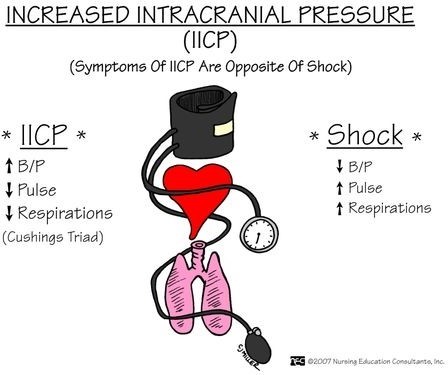The practical nurse (PN) is monitoring the neurological vital signs of a client with a recently closed head injury. Which vital sign trends indicate increased intracranial pressure (ICP) and should be reported to the charge nurse?
Heart rate above 110 beats/minute, elevated respiratory rate, and hypotension.
Bounding pulse rate, groaning respiratory effort, and elevated blood pressure.
Thready rapid pulse, trembling, perspiration, weakness, and irritability.
Bradycardia, irregular respiratory patterns, widening pulse pressure.
The Correct Answer is D
The vital sign trends that indicate increased intracranial pressure (ICP) and should be reported to the charge nurse are:
Bradycardia: A slow heart rate can be a sign of increased ICP.
Irregular respiratory patterns: Abnormal breathing patterns, such as irregular or Cheyne-Stokes respirations, can be indicative of increased ICP.
Widening pulse pressure: An increased difference between systolic and diastolic blood pressure (widening pulse pressure) can be a sign of increased ICP.

A- Heart rate above 110 beats/minute, elevated respiratory rate, and hypotension: While an elevated heart rate and respiratory rate can be associated with increased ICP, hypotension (low blood pressure) is not typically seen in this condition. Hypotension can be a sign of other factors, such as hypovolemia or shock, which may or may not be related to the head injury.
B- Bounding pulse rate, groaning respiratory effort, and elevated blood pressure: Bounding pulse rate and elevated blood pressure are not specific to increased ICP. They can be influenced by other factors such as pain, anxiety, or medications. Groaning respiratory effort may indicate respiratory distress, but it is not directly related to increased ICP.
C- Thready rapid pulse, trembling, perspiration, weakness, and irritability: These signs and symptoms can be associated with various conditions such as anxiety, stress, or other physiological responses. While they may occur in the context of increased ICP, they are not specific to this condition alone.
Nursing Test Bank
Naxlex Comprehensive Predictor Exams
Related Questions
Correct Answer is A
Explanation
When a client refuses to look at their mastectomy incision and refuses to talk about it, the best response by the practical nurse (PN) is to respect the client's autonomy and validate their feelings. Option a) acknowledges the client's discomfort and provides reassurance that it is okay for them to decline to look or talk about the incision at the moment. It also offers support by letting the client know that the incision will be available for examination when they feel ready to do so.
Correct Answer is A
Explanation
A. Checking the child’s blood glucose level via fingerstick is the most important step before administering insulin to prevent hypoglycemia or ensure the appropriate dose.
B. Exercise affects blood sugar, but the immediate priority is verifying the blood glucose level.
C. Urination patterns can indicate hyperglycemia, but they are not the most critical factor before insulin administration.
D. Eating is important, but insulin dosing should be based on blood glucose readings and meal intake combined.
Whether you are a student looking to ace your exams or a practicing nurse seeking to enhance your expertise , our nursing education contents will empower you with the confidence and competence to make a difference in the lives of patients and become a respected leader in the healthcare field.
Visit Naxlex, invest in your future and unlock endless possibilities with our unparalleled nursing education contents today
Report Wrong Answer on the Current Question
Do you disagree with the answer? If yes, what is your expected answer? Explain.
Kindly be descriptive with the issue you are facing.
